Medicinal Plants and Mushrooms with Immunomodulatory and Anticancer Properties—A Review on Hong Kong’s Experience
Abstract
1. Introduction
2. The Hong Kong Experience: Immunological Properties of Medicinal Herbs Used Against Cancer
2.1. Agaricus blazei
2.2. Ganoderma lucidum and Ganoderma sinense
2.3. Rubinoboletus ballouii
2.4. Acanthopanax senticosus
2.5. Astragalus membranaceus
2.6. Curcuma longa
2.7. Hedyotis Species
2.8. Scutellaria barbata
3. The Hong Kong Experience on Clinical Applications
3.1. Testing the Immunomodulatory Effects of Coriolus versicolor and Salvia miltiorrhiza Capsules in Healthy Subjects—A Randomized, Double-Blind, Placebo-Controlled, Crossover Study
3.2. Coriolus and Salvia for Patients Suffering from Nasopharyngeal Carcinoma
3.3. Coriolus and Salvia for Breast Cancer Patients after Completion of Treatment
4. Common Target Areas That Investigators Used to Study the Bioactivities Related to Immunological Properties of Medicinal Plants:
4.1. Organs Related to the Provision of Relevant Cells and Cellular Activities: [73]
- bone marrow,
- thymus,
- lymph nodes and lymphatic system, and
- spleen.
4.2. Activity of Macrophages: [74]
- engulfing ability and
- anticancer activities.
4.3. Immune Cells—T Cells, B Cells, Natural Killer (NK) Cells: [75,76]
- T cells’ responses give good pictures of anti-infection and anticancer influences,
- B cells could be studied on their responses to polysaccharide stimulation, and
- NK cell’s direct cytotoxic effects have been observed.
4.4. Cytokines, Interleukin Production [77,78]
5. Discussion
Author Contributions
Funding
Acknowledgments
Conflicts of Interest
References
- Wang, H.C. Ancent thoughts and practices related to immunology. China J. Immunol. 1993, 9, 237. (In Chinese) [Google Scholar]
- Kung, H.Y. Study on the immuno-pharmacology of 21 herbs. Pharmacol. Chin. Med. 1995, 30. [Google Scholar]
- Ragupathi, G.; Yeung, K.S.; Leung, P.C.; Lee, M.; Lau, C.B.S.; Vickers, A.; Hood, C.; Deng, G.; Cheung, N.K.; Cassileth, B.; et al. Evaluation of widely consumed botanicals as immunological adjuvants. Vaccine 2008, 26, 4860–4865. [Google Scholar] [CrossRef]
- Hong, F.; Xiao, W.; Ragupathi, G.; Lau, C.B.S.; Leung, P.C.; Yeung, K.S.; George, C.; Cassileth, B.; Kennelly, E.; Livingston, P.O. The known immunologically active components of Astragalus account for only a small proportion of the immunological adjuvant activity when combined with conjugate vaccines. Planta Med. 2011, 77, 817–824. [Google Scholar] [CrossRef] [PubMed]
- Xiao, W.L.; Motley, T.J.; Unachukwu, U.J.; Lau, C.B.S.; Jiang, B.; Hong, F.; Leung, P.C.; Wang, Q.F.; Livingston, P.O.; Cassileth, B.R.; et al. Chemical and genetic assessment of variability in commercial Radix Astragali (Astragalus spp.) by ion trap LC-MS and nuclear ribosomal DNA barcoding sequence analyses. J. Agric. Food Chem 2011, 59, 1548–1556. [Google Scholar] [CrossRef]
- Yue, G.G.L.; Chan, B.C.; Hon, P.M.; Kennelly, E.J.; Yeung, S.K.; Cassileth, B.R.; Fung, K.P.; Leung, P.C.; Lau, C.B.S. Immunostimulatory activities of polysaccharide extract isolated from Curcuma longa. Int. J. Biol. Macromol. 2010, 47, 342–347. [Google Scholar] [CrossRef]
- Yue, G.G.L.; Chan, B.C.L.; Hon, P.M.; Lee, M.Y.H.; Fung, K.P.; Leung, P.C.; Lau, C.B.S. Evaluation of in vitro anti-proliferative and immunomodulatory activities of compounds isolated from Curcuma longa. Food Chem. Toxicol. 2010, 48, 2011–2020. [Google Scholar] [CrossRef]
- Li, L.F.; Chan, B.C.; Yue, G.G.L.; Lau, C.B.S.; Han, Q.B.; Leung, P.C.; Liu, J.K.; Fung, K.P. Two immunosuppressive compounds from the mushroom Rubinoboletus ballouii using human peripheral blood mononuclear cells by bioactivity-guided fractionation. Phytomedicine 2013, 20, 1196–1202. [Google Scholar] [CrossRef]
- Li, L.F.; Yue, G.G.L.; Chan, B.C.; Zeng, Q.; Han, Q.B.; Leung, P.C.; Fung, K.P.; Liu, J.K.; Lau, C.B.S. Rubinoboletus ballouii polysaccharides exhibited immunostimulatory activities through toll-like receptor-4 via NF-kappaB pathway. Phytother. Res. 2020. [Google Scholar] [CrossRef] [PubMed]
- Kimura, Y.; Kido, T.; Takaku, T.; Sumiyoshi, M.; Baba, K. Isolation of an anti-angiogenic substance from Agaricus blazei Murill: Its antitumor and antimetastatic actions. Cancer Sci. 2004, 95, 758–764. [Google Scholar] [CrossRef]
- Hetland, G.; Tangen, J.M.; Mahmood, F.; Mirlashari, M.R.; Nissen-Meyer, L.S.H.; Nentwich, I.; Therkelsen, S.P.; Tjonnfjord, G.E.; Johnson, E. Antitumor, anti-inflammatory and antiallergic effects of Agaricus blazei mushroom extract and the related medicinal Basidiomycetes mushrooms, Hericium erinaceus and Grifola frondosa: A review of preclinical and clinical studies. Nutrients 2020, 12, 1339. [Google Scholar] [CrossRef]
- Kim, C.F.; Jiang, J.J.; Leung, K.N.; Fung, K.P.; Lau, C.B.S. Inhibitory effects of Agaricus blazei extracts on human myeloid leukemia cells. J. Ethnopharmacol. 2009, 122, 320–366. [Google Scholar] [CrossRef] [PubMed]
- Hui, T.; Guo, L.; Wang, J.; Ito, H.; Simura, K. Clinical observation on treatment of acute nonlymphocytic leukemia with Agaricus blazei Murill. J. Lanzhou Med. Coll. 1994, 20, 169–171. [Google Scholar]
- Ahn, W.S.; Kim, D.J.; Chae, G.T.; Lee, J.M.; Bae, S.M.; Sin, J.I.; Kim, Y.W.; Namkoong, S.E.; Lee, I.P. Natural killer cell activity and quality of life were improved by consumption of a mushroom extract, Agaricus blazei Murill Kyowa, in gynecological cancer patients undergoing chemotherapy. Int, J. Gynecol. Cancer 2004, 14, 589–594. [Google Scholar] [CrossRef]
- Yoshimura, K.; Kamoto, T.; Ogawa, O.; Matsui, S.; Tsuchiya, N.; Tada, H.; Murata, K.; Yoshimura, K.; Habuchi, T.; Fukushima, M. Medical mushrooms used for biochemical failure after radical treatment for prostate cancer: An open-label study. Int. J. Urol. 2010, 17, 548–554. [Google Scholar] [CrossRef] [PubMed]
- Mukai, H.; Watanabe, T.; Ando, M.; Katsumata, N. An alternative medicine, Agaricus blazei, may have induced severe hepatic dysfunction in cancer patients. Jpn, J. Clin. Oncol. 2006, 36, 808–810. [Google Scholar] [CrossRef]
- Yue, G.G.L.; Fung, K.P.; Tse, G.M.; Leung, P.C.; Lau, C.B.S. Comparative studies of various Ganoderma species and their different parts with regard to their antitumor and immunomodulating activities in vitro. J. Altern. Complement. Med. 2006, 12, 777–789. [Google Scholar] [CrossRef]
- Yue, G.G.L.; Lau, C.B.S.; Fung, K.P.; Leung, P.C. Studies on the anti-tumor activities of Ganoderma lucidum (Lingzhi): A comparison with two allied species and the different parts of their fruiting bodies. Environ. Mol. Mutagen. 2006, 47, 424. [Google Scholar]
- Yue, G.G.L.; Fung, K.P.; Leung, P.C.; Lau, C.B.S. Comparative studies on the immunomodulatory and antitumor activities of the different parts of fruiting body of Ganoderma lucidum and Ganoderma spores. Phytother. Res. 2008, 22, 1282–1291. [Google Scholar] [CrossRef]
- Yue, G.G.L.; Chan, B.C.; Han, X.Q.; Cheng, L.; Wong, E.C.; Leung, P.C.; Fung, K.P.; Ng, M.C.; Fan, K.; Sze, D.M.; et al. Immunomodulatory activities of Ganoderma sinense polysaccharides in human immune cells. Nutr. Cancer 2013, 65, 765–774. [Google Scholar] [CrossRef]
- Han, X.Q.; Chan, B.C.L.; Dong, C.X.; Yang, Y.H.; Ko, C.H.; Yue, G.G.L.; Chen, D.; Wong, C.K.; Lau, C.B.S.; Tu, P.F.; et al. Isolation, structure characterization, and immunomodulating activity of a hyperbranched polysaccharide from the fruiting bodies of Ganoderma sinense. J. Agr. Food Chem. 2012, 60, 4276–4281. [Google Scholar] [CrossRef]
- Han, X.Q.; Chan, B.C.; Yu, H.; Yang, Y.H.; Hu, S.Q.; Ko, C.H.; Dong, C.X.; Wong, C.K.; Shaw, P.C.; Fung, K.P.; et al. Structural characterization and immuno-modulating activities of a polysaccharide from Ganoderma sinense. Int. J. Biol. Macromol. 2012, 51, 597–603. [Google Scholar] [CrossRef]
- Han, X.Q.; Yue, G.G.L.; Yue, R.Q.; Dong, C.X.; Chan, C.L.; Ko, C.H.; Cheung, W.S.; Luo, K.W.; Dai, H.; Wong, C.K.; et al. Structure elucidation and immunomodulatory activity of a beta glucan from the fruiting bodies of Ganoderma sinense. PLoS ONE 2014, 9, e100380. [Google Scholar] [CrossRef]
- Chan, K.M.; Yue, G.G.L.; Li, P.; Wong, E.C.; Lee, J.K.; Kennelly, E.J.; Lau, C.B.S. Screening and analysis of potential anti-tumor components from the stipe of Ganoderma sinense using high-performance liquid chromatography/time-of-flight mass spectrometry with multivariate statistical tool. J. Chromatogr. A 2017, 1487, 162–167. [Google Scholar] [CrossRef]
- Jin, X.; Ruiz Beguerie, J.; Sze, D.M.; Chan, G.C. Ganoderma lucidum (Reishi mushroom) for cancer treatment. Cochrane Database Syst. Rev. 2016, 4, CD007731. [Google Scholar] [CrossRef]
- Zhao, H.; Zhang, Q.; Zhao, L.; Huang, X.; Wang, J.; Kang, X. Spore powder of Ganoderma lucidum improves cancer-related fatigue in breast cancer patients undergoing endocrine therapy: A pilot clinical trial. Evid Based Complement. Alternat. Med. 2012, 2012, 809614. [Google Scholar] [CrossRef] [PubMed]
- Keller, S.A.; Klukowska-Rotzler, J.; Schenk-Jaeger, K.M.; Kupferschmidt, H.; Exadaktylos, A.K.; Lehmann, B.; Liakoni, E. Mushroom poisoning-a 17 year retrospective study at a level I university emergency department in Switzerland. Int. J. Environ. Res. Public Health 2018, 15, 2855. [Google Scholar] [CrossRef] [PubMed]
- White, J.; Weinstein, S.A.; De Haro, L.; Bedry, R.; Schaper, A.; Rumack, B.H.; Zilker, T. Mushroom poisoning: A proposed new clinical classification. Toxicon 2019, 157, 53–65. [Google Scholar] [CrossRef]
- Lemieszek, M.K.; Ribeiro, M.; Guichard Alves, H.; Marques, G.; Nunes, F.M.; Rzeski, W. Boletus edulis ribonucleic acid—A potent apoptosis inducer in human colon adenocarcinoma cells. Food Funct. 2016, 7, 3163–3175. [Google Scholar] [CrossRef] [PubMed]
- Zhang, L.; Hu, Y.; Duan, X.; Tang, T.; Shen, Y.; Hu, B.; Liu, A.; Chen, H.; Li, C.; Liu, Y. Characterization and antioxidant activities of polysaccharides from thirteen Boletus mushrooms. Int. J. Biol. Macromol. 2018, 113, 1–7. [Google Scholar] [CrossRef] [PubMed]
- Zhang, L.; Meng, B.; Li, L.; Wang, Y.; Zhang, Y.; Fang, X.; Wang, D. Boletus aereus protects against acute alcohol-induced liver damage in the C57BL/6 mouse via regulating the oxidative stress-mediated NF-kappaB pathway. Pharm. Biol. 2020, 58, 905–914. [Google Scholar] [CrossRef] [PubMed]
- Lau, K.M.; Yue, G.G.L.; Chan, Y.Y.; Kwok, H.F.; Gao, S.; Wong, C.W.; Lau, C.B.S. A review on the immunomodulatory activity of Acanthopanax senticosus and its active components. Chin. Med. 2019, 14, 25. [Google Scholar] [CrossRef] [PubMed]
- Yue, G.G.L.; Kwok, H.F.; Lee, J.K.M.; Jiang, L.; Chan, K.M.; Cheng, L.; Wong, E.C.W.; Leung, P.C.; Fung, K.P.; Lau, C.B.S. Novel anti-angiogenic effects of aromatic-turmerone, essential oil isolated from spice turmeric. J. Funct. Foods 2015, 15, 243–253. [Google Scholar] [CrossRef]
- Yue, G.G.L.; Cheng, S.W.; Yu, H.; Xu, Z.S.; Lee, J.K.M.; Hon, P.M.; Lee, M.Y.H.; Kennelly, E.J.; Deng, G.; Yeung, S.K.; et al. The role of turmerones on curcumin transportation and p-glycoprotein activities in intestinal Caco-2 cells. J. Med. Food 2012, 15, 242–252. [Google Scholar] [CrossRef] [PubMed]
- Yue, G.G.L.; Jiang, L.; Kwok, H.F.; Lee, J.K.M.; Chan, K.M.; Fung, K.P.; Leung, P.C.; Lau, C.B.S. Turmeric ethanolic extract possesses stronger inhibitory activities on colon tumour growth than curcumin—The importance of turmerones. J. Funct. Foods 2016, 22, 565–577. [Google Scholar] [CrossRef]
- Yue, G.G.L.; Kwok, H.F.; Lee, J.K.M.; Jiang, L.; Wong, E.C.W.; Gao, S.; Wong, H.L.; Li, L.; Chan, K.M.; Leung, P.C.; et al. Combined therapy using bevacizumab and turmeric ethanolic extract (with absorbable curcumin) exhibited beneficial efficacy in colon cancer mice. Pharmacol. Res. 2016, 111, 43–57. [Google Scholar] [CrossRef]
- Li, M.; Yue, G.G.L.; Tsui, S.K.; Fung, K.P.; Lau, C.B.S. Turmeric extract, with absorbable curcumin, has potent anti-metastatic effect in vitro and in vivo. Phytomedicine 2018, 46, 131–141. [Google Scholar] [CrossRef] [PubMed]
- Li, M.; Yue, G.G.L.; Luo, L.; Tsui, S.K.W.; Fung, K.P.; Ng, S.S.M.; Lau, C.B.S. Turmeric is therapeutic in vivo on patient-derived colorectal cancer xenografts: Inhibition of growth, metastasis, and tumor recurrence. Front. Oncol. 2021, 10, 574827. [Google Scholar] [CrossRef]
- Lau, C.B.S.; Cheng, L.; Cheng, B.W.; Yue, G.G.L.; Wong, E.C.; Lau, C.P.; Leung, P.C.; Fung, K.P. Development of a simple chromatographic method for distinguishing between two easily confused species, Hedyotis diffusa and Hedyotis corymbosa. Nat. Prod. Res. 2012, 26, 1446–1450. [Google Scholar] [CrossRef]
- Yue, G.G.L.; Lee, J.K.M.; Cheng, L.; Chan, B.C.L.; Jiang, L.; Fung, K.P.; Leung, P.C.; Lau, C.B.S. Reversal of P-glycoprotein-mediated multidrug resistance in human hepatoma cells by hedyotiscone A, a compound isolated from Hedyotis corymbosa. Xenobiotica 2012, 42, 562–570. [Google Scholar] [CrossRef]
- Yue, G.G.L.; Lee, J.K.; Kwok, H.F.; Cheng, L.; Wong, E.C.; Jiang, L.; Yu, H.; Leung, H.W.; Wong, Y.L.; Leung, P.C.; et al. Novel PI3K/AKT targeting anti-angiogenic activities of 4-vinylphenol, a new therapeutic potential of a well-known styrene metabolite. Sci. Rep. 2015, 5, 11149. [Google Scholar] [CrossRef]
- Chan, J.Y.; Tang, P.M.; Hon, P.M.; Au, S.W.; Tsui, S.K.; Waye, M.M.; Kong, S.K.; Mak, T.C.; Fung, K.P. Pheophorbide a, a major antitumor component purified from Scutellaria barbata, induces apoptosis in human hepatocellular carcinoma cells. Planta Med. 2006, 72, 28–33. [Google Scholar] [CrossRef]
- Tang, P.M.; Chan, J.Y.; Au, S.W.; Kong, S.K.; Tsui, S.K.; Waye, M.M.; Mak, T.C.; Fong, W.P.; Fung, K.P. Pheophorbide a, an active compound isolated from Scutellaria barbata, possesses photodynamic activities by inducing apoptosis in human hepatocellular carcinoma. Cancer Biol. Ther. 2006, 5, 1111–1116. [Google Scholar] [CrossRef]
- Hoi, S.W.; Wong, H.M.; Chan, J.Y.; Yue, G.G.; Tse, G.M.; Law, B.K.; Fong, W.P.; Fung, K.P. Photodynamic therapy of Pheophorbide a inhibits the proliferation of human breast tumour via both caspase-dependent and -independent apoptotic pathways in in vitro and in vivo models. Phytother. Res. 2012, 26, 734–742. [Google Scholar] [CrossRef]
- Yue, G.G.L.; Chan, Y.Y.; Liu, W.; Gao, S.; Wong, C.W.; Lee, J.K.; Lau, K.M.; Lau, C.B.S. Effectiveness of Scutellaria barbata water extract on inhibiting colon tumor growth and metastasis in tumor-bearing mice. Phytother. Res. 2021, 35, 361–373. [Google Scholar] [CrossRef]
- Shen, M.L.; Zhai, S.K.; Chen, H.L.; Luo, Y.D.; Tu, G.R.; Ou, D.W. Immunomopharmacological effects of polysaccharides from Acanthopanax senticosus on experimental animals. Int. J. Immunopharmacol. 1991, 13, 549–554. [Google Scholar] [CrossRef]
- Wang, J.; Li, G.; Yu, L.; Mo, T.; Wu, Q.; Zhou, Z. Aidi injection plus platinum-based chemotherapy for stage IIIB/IV non-small cell lung cancer: A meta-analysis of 42 RCTs following the PRISMA guidelines. J. Ethnopharmacol. 2018, 221, 137–150. [Google Scholar] [CrossRef] [PubMed]
- Xiao, Z.; Wang, C.; Zhou, M.; Hu, S.; Jiang, Y.; Huang, X.; Li, N.; Feng, J.; Tang, F.; Chen, X.; et al. Clinical efficacy and safety of Aidi injection plus paclitaxel-based chemotherapy for advanced non-small cell lung cancer: A meta-analysis of 31 randomized controlled trials following the PRISMA guidelines. J. Ethnopharmacol. 2019, 228, 110–122. [Google Scholar] [CrossRef]
- Zhang, Y.; Wu, J.; Guo, S.; Lin, W.; Zhang, B.; Chen, X.; Mo, H.; Zhan, T. The clinical efficacy and safety of the Chinese herbal medicine Astragalus (Huangqi) preparation for the treatment of acute myocardial infarction: A systematic review of randomized controlled trials. Medicine 2019, 98, e15256. [Google Scholar] [CrossRef] [PubMed]
- Zhang, L.; Shergis, J.L.; Yang, L.; Zhang, A.L.; Guo, X.; Zhang, L.; Zhou, S.; Zeng, L.; Mao, W.; Xue, C.C. Astragalus membranaceus (Huang Qi) as adjunctive therapy for diabetic kidney disease: An updated systematic review and meta-analysis. J. Ethnopharmacol. 2019, 239, 111921. [Google Scholar] [CrossRef]
- Dugoua, J.J.; Wu, P.; Seely, D.; Eyawo, O.; Mills, E. Astragalus-containing Chinese herbal combinations for advanced non-small-cell lung cancer: A meta-analysis of 65 clinical trials enrolling 4751 patients. Lung Cancer 2010, 1, 85–100. [Google Scholar]
- Guo, L.; Bai, S.P.; Zhao, L.; Wang, X.H. Astragalus polysaccharide injection integrated with vinorelbine and cisplatin for patients with advanced non-small cell lung cancer: Effects on quality of life and survival. Med. Oncol. 2012, 29, 1656–1662. [Google Scholar] [CrossRef] [PubMed]
- Hsieh, C.H.; Lin, C.Y.; Hsu, C.L.; Fan, K.H.; Huang, S.F.; Liao, C.T.; Lee, L.Y.; Ng, S.K.; Yen, T.C.; Chang, J.T.; et al. Incorporation of Astragalus polysaccharides injection during concurrent chemoradiotherapy in advanced pharyngeal or laryngeal squamous cell carcinoma: Preliminary experience of a phase II double-blind, randomized trial. J. Cancer Res. Clin. Oncol. 2020, 146, 33–41. [Google Scholar] [CrossRef]
- Gupta, N.; Verma, K.; Nalla, S.; Kulshreshtha, A.; Lall, R.; Prasad, S. Free radicals as a double-edged sword: The cancer preventive and therapeutic roles of curcumin. Molecules 2020, 25, 5390. [Google Scholar] [CrossRef] [PubMed]
- Ahmad, R.S.; Hussain, M.B.; Sultan, M.T.; Arshad, M.S.; Waheed, M.; Shariati, M.A.; Plygun, S.; Hashempur, M.H. Biochemistry, safety, pharmacological activities, and clinical applications of turmeric: A mechanistic review. Evid Based Complement. Alternat. Med. 2020, 2020, 7656919. [Google Scholar] [CrossRef]
- Sharifi-Rad, J.; Rayess, Y.E.; Rizk, A.A.; Sadaka, C.; Zgheib, R.; Zam, W.; Sestito, S.; Rapposelli, S.; Neffe-Skocinska, K.; Zielinska, D.; et al. Turmeric and its major compound curcumin on health: Bioactive effects and safety profiles for food, pharmaceutical, biotechnological and medicinal applications. Front. Pharmacol. 2020, 11, 01021. [Google Scholar] [CrossRef] [PubMed]
- Schaffer, M.; Schaffer, P.M.; Bar-Sela, G. An update on Curcuma as a functional food in the control of cancer and inflammation. Curr. Opin. Clin. Nutr. Metab. Care 2015, 18, 605–611. [Google Scholar] [CrossRef] [PubMed]
- White, C.M.; Pasupuleti, V.; Roman, Y.M.; Li, Y.; Hernandez, A.V. Oral turmeric/curcumin effects on inflammatory markers in chronic inflammatory diseases: A systematic review and meta-analysis of randomized controlled trials. Pharmacol. Res. 2019, 146, 104280. [Google Scholar] [CrossRef] [PubMed]
- Salehi, B.; Stojanovic-Radic, Z.; Matejic, J.; Sharifi-Rad, M.; Anil Kumar, N.V.; Martins, N.; Sharifi-Rad, J. The therapeutic potential of curcumin: A review of clinical trials. Eur. J. Med. Chem. 2019, 163, 527–545. [Google Scholar] [CrossRef]
- Mansouri, K.; Rasoulpoor, S.; Daneshkhah, A.; Abolfathi, S.; Salari, N.; Mohammadi, M.; Rasoulpoor, S.; Shabani, S. Clinical effects of curcumin in enhancing cancer therapy: A systematic review. BMC Cancer 2020, 20, 791. [Google Scholar] [CrossRef]
- Niu, Y.; Meng, Q.X. Chemical and preclinical studies on Hedyotis diffusa with anticancer potential. J. Asian Nat. Prod. Res. 2013, 15, 550–565. [Google Scholar] [CrossRef] [PubMed]
- Chen, R.; He, J.; Tong, X.; Tang, L.; Liu, M. The Hedyotis diffusa Willd. (Rubiaceae): A review on phytochemistry, pharmacology, quality control and pharmacokinetics. Molecules 2016, 21, 710. [Google Scholar] [CrossRef] [PubMed]
- Kuo, Y.T.; Chang, T.T.; Muo, C.H.; Wu, M.Y.; Sun, M.F.; Yeh, C.C.; Yen, H.R. Use of complementary traditional Chinese medicines by adult cancer patients in Taiwan: A nationwide population-based study. Integr. Cancer Ther. 2018, 17, 531–541. [Google Scholar] [CrossRef]
- Yeh, Y.C.; Chen, H.Y.; Yang, S.H.; Lin, Y.H.; Chiu, J.H.; Lin, Y.H.; Chen, J.L. Hedyotis diffusa combined with Scutellaria barbata are the core treatment of Chinese herbal medicine used for breast cancer patients: A population-based study. Evid Based Complement. Alternat. Med. 2014, 2014, 202378. [Google Scholar] [CrossRef] [PubMed]
- Zhou, Q.R.; Chen, M.Y.; Wang, M.D. Treatment of chronic endometritis by penning granule: A clinical randomized controlled trial. Zhongguo Zhong Xi Yi Jie He Za Zhi 2016, 36, 1055–1060. (In Chinese) [Google Scholar]
- Chen, Q.; Rahman, K.; Wang, S.J.; Zhou, S.; Zhang, H. Scutellaria barbata: A review on chemical constituents, pharmacological activities and clinical applications. Curr. Pharm. Des. 2020, 26, 160–175. [Google Scholar] [CrossRef] [PubMed]
- Rugo, H.; Shtivelman, E.; Perez, A.; Vogel, C.; Franco, S.; Tan Chiu, E.; Melisko, M.; Tagliaferri, M.; Cohen, I.; Shoemaker, M.; et al. Phase I trial and antitumor effects of BZL101 for patients with advanced breast cancer. Breast Cancer Res. Treat. 2007, 105, 17–28. [Google Scholar] [CrossRef]
- Perez, A.T.; Arun, B.; Tripathy, D.; Tagliaferri, M.A.; Shaw, H.S.; Kimmick, G.G.; Cohen, I.; Shtivelman, E.; Caygill, K.A.; Grady, D.; et al. A phase 1B dose escalation trial of Scutellaria barbata (BZL101) for patients with metastatic breast cancer. Breast Cancer Res. Treat. 2010, 120, 111–118. [Google Scholar] [CrossRef]
- Li, X.Y. Advances in Immunomodulatin studies of PSP. In Advanced Research in PSP 1999; Yang, Q.Y., Ed.; Winsor Health Products Ltd.: Hong Kong, China, 1999. [Google Scholar]
- Wong, C.K.; Tse, P.S.; Wong, E.L.Y.; Leung, P.C.; Fung, K.P.; Lam, C.W.K. Immunomodulatory effects of Yunzhi and Danshen capsules in health subjects—A randomized, double-blind, placebo-controlled, crossover study. Int. Immunopharmacol. 2004, 4, 201–211. [Google Scholar] [CrossRef]
- Bao, Y.X.; Wong, C.K.; Leung, S.F.; Chan, A.T.C.; Li, P.W.; Wong, E.L.Y.; Leung, P.C.; Fung, K.P.; Yin, Y.B.; Lam, C.W.K. Clinical studies of immunomodulatory activities of Yunzhi-Danshen in patients with nasopharyngeal carcinoma. J. Altern. Complement. Med. 2006, 12, 771–776. [Google Scholar] [CrossRef]
- Wong, C.K.; Bao, Y.X.; Wong, E.L.Y.; Leung, P.C.; Fung, K.P.; Lam, C.W.K. Immunomodulatory activities of Yunzhi and Danshen in post-treatment breast cancer patients. Am. J. Chin. Med. 2005, 33, 381–395. [Google Scholar] [CrossRef]
- Wai, S.Y. Influence of Astragalus on the thymes of mice of University of Pharmacology. Am. J. Chin. Med. 1991, 22, 359. [Google Scholar]
- Wang, S.L. Effects of 8 herbal extracts on the intraperitoneal macrophages. J. Bai J.Y. Univ. 1990, 16, 325. [Google Scholar]
- Ko, S.T. Five anti-aging herbal extracts acting on T cells multiplication and IL2 production. J. China Univ. Pharmacol. 1990, 21, 43. [Google Scholar]
- Yang, G.Z.; Bao, T.; Geng, P.L. Immunoregulatory effects of ginsenoside in vivo and in vitro. J. Tradit. Chin. Med. 1986, 6, 191–194. [Google Scholar]
- Wang, B.K. Effect of Lycuim barbarum polysaccharides on the immune responses of T, CTL and NK cells in normal and cyclophosphamide treated mice. China J. Pharmacol. Toxicol. 1990, 4, 39. [Google Scholar]
- Lei, L.S. Effects of Ganoderma polysaccharides on T cell subpopulation and production of IL2 in mixed lymphocyte responses. Aceta Pharm Sin. 1992, 27, 331. [Google Scholar]
- Chou, K.Y. Human immune suppression is inducable by trichosanthin via CD8 cell mediated pathway. J. Cell Res. 1994, 4, 17. [Google Scholar] [CrossRef][Green Version]
- Sasaki, H.; Nishimura, H.; Morota, T.; Chin, M.; Mitsuhashi, H.; Komatsu, Y.; Maruyama, H.; Guo-Rui, T.; Wei, H.; Yu-Lang, X. Immunosuppressive principles of Rehmannia glutinosa var. hueichingensis. Planta Med. 1989, 55, 458–462. [Google Scholar] [CrossRef] [PubMed]
- Allkin, B. Medicines: At least 28,187 plant species are currently recorded as being of medicinal use. In State of the World’s Plants 2017; Willis, K.J., Ed.; Royal Botanic Kew Gardens: London, UK, 2017. [Google Scholar]
- Smith, T.; May, G.; Eckl, V.; Reynolds, C.M. US Sales of Herbal Supplements Increase by 8.6% in 2019. HerbalGram 2020, 127, 54–69. [Google Scholar]
- Zahn, R.; Perry, N.; Perry, E.; Mukaetova-Ladinska, E.B. Use of herbal medicines: Pilot survey of UK users’ views. Complement. Ther. Med. 2019, 44, 83–90. [Google Scholar] [CrossRef] [PubMed]
- Ferlay, J.; Ervik, M.; Lam, F.; Colombet, M.; Mery, L.; Piñeros, M.; Znaor, A.; Soerjomataram, I.; Bray, F. Global Cancer Observatory: Cancer Today. Available online: https://gco.iarc.fr/today (accessed on 26 January 2021).
- Deng, G.; Cassileth, B. Complementary or alternative medicine in cancer care-myths and realities. Nat. Rev. Clin. Oncol 2013, 10, 656–664. [Google Scholar] [CrossRef] [PubMed]
- Werneke, U.; Earl, J.; Seydel, C.; Horn, O.; Crichton, P.; Fannon, D. Potential health risks of complementary alternative medicines in cancer patients. Br. J. Cancer 2004, 90, 408–413. [Google Scholar] [CrossRef] [PubMed]
- Newman, D.J.; Cragg, G.M. Natural products as sources of new drugs over the nearly four decades from 01/1981 to 09/2019. J. Nat. Prod. 2020, 83, 770–803. [Google Scholar] [CrossRef]
- Eardley, S.; Bishop, F.L.; Prescott, P.; Cardini, F.; Brinkhaus, B.; Santos-Rey, K.; Vas, J.; von Ammon, K.; Hegyi, G.; Dragan, S.; et al. A systematic literature review of complementary and alternative medicine prevalence in EU. Forsch Komplementmed 2012, 19, 18–28. [Google Scholar] [CrossRef] [PubMed]
- Enioutina, E.Y.; Salis, E.R.; Job, K.M.; Gubarev, M.I.; Krepkova, L.V.; Sherwin, C.M. Herbal Medicines: Challenges in the modern world. Part 5. status and current directions of complementary and alternative herbal medicine worldwide. Expert Rev. Clin. Pharmacol. 2017, 10, 327–338. [Google Scholar] [CrossRef]
- Menniti-Ippolito, F.; Gargiulo, L.; Bologna, E.; Forcella, E.; Raschetti, R. Use of unconventional medicine in Italy: A nation-wide survey. Eur, J. Clin. Pharmacol. 2002, 58, 61–64. [Google Scholar] [CrossRef]
- Welz, A.N.; Emberger-Klein, A.; Menrad, K. Why people use herbal medicine: Insights from a focus-group study in Germany. BMC Complement. Altern Med. 2018, 18, 92. [Google Scholar] [CrossRef]
- Lam, Y.C.; Cheng, C.W.; Peng, H.; Law, C.K.; Huang, X.; Bian, Z. Cancer patients’ attitudes towards Chinese medicine: A Hong Kong survey. Chin. Med. 2009, 4, 25. [Google Scholar] [CrossRef]
- Lu, C.L.; Li, X.; Zhou, H.M.; Zhang, C.; Yang, Y.Y.; Feng, R.L.; Long, C.J.; Deng, F.Y.; Li, J.C.; Cao, Z.M.; et al. Randomised controlled trials of traditional Chinese medicine in cancer care published in Chinese: An overview. Lancet 2019, 394, S26. [Google Scholar] [CrossRef]
- So, T.H.; Chan, S.K.; Lee, V.H.; Chen, B.Z.; Kong, F.M.; Lao, L.X. Chinese medicine in cancer treatment—how is it practised in the east and the west? Clin. Oncol. 2019, 31, 578–588. [Google Scholar] [CrossRef] [PubMed]
- Nie, J.; Zhao, C.; Deng, L.I.; Chen, J.; Yu, B.; Wu, X.; Pang, P.; Chen, X. Efficacy of traditional Chinese medicine in treating cancer. Biomed. Rep. 2016, 4, 3–14. [Google Scholar] [CrossRef] [PubMed]
- Wu, J.; Liu, Y.; Fang, C.; Zhao, L.; Lin, L.; Lu, L. Traditional Chinese medicine preparation combined therapy may improve chemotherapy efficacy: A systematic review and meta-analysis. Evid. Based Complement. Alternat. Med. 2019, 5015824. [Google Scholar] [CrossRef] [PubMed]
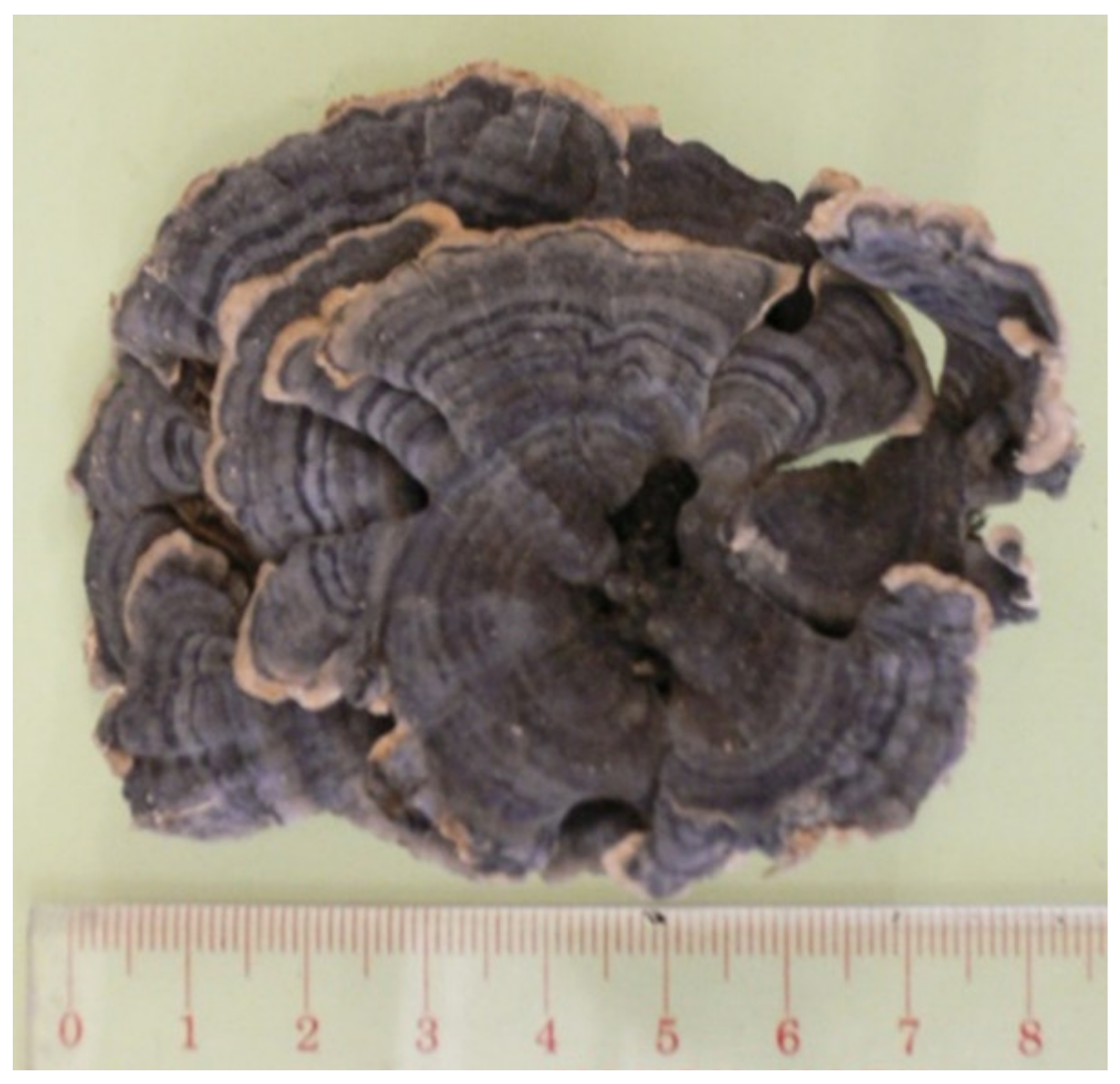
| Name | Photos of Plants/Mushrooms | Main Habitat | Medicinal Use | Main Active Chemical Component | Our Main Research Findings | References |
|---|---|---|---|---|---|---|
| (1) Agaricus blazei | 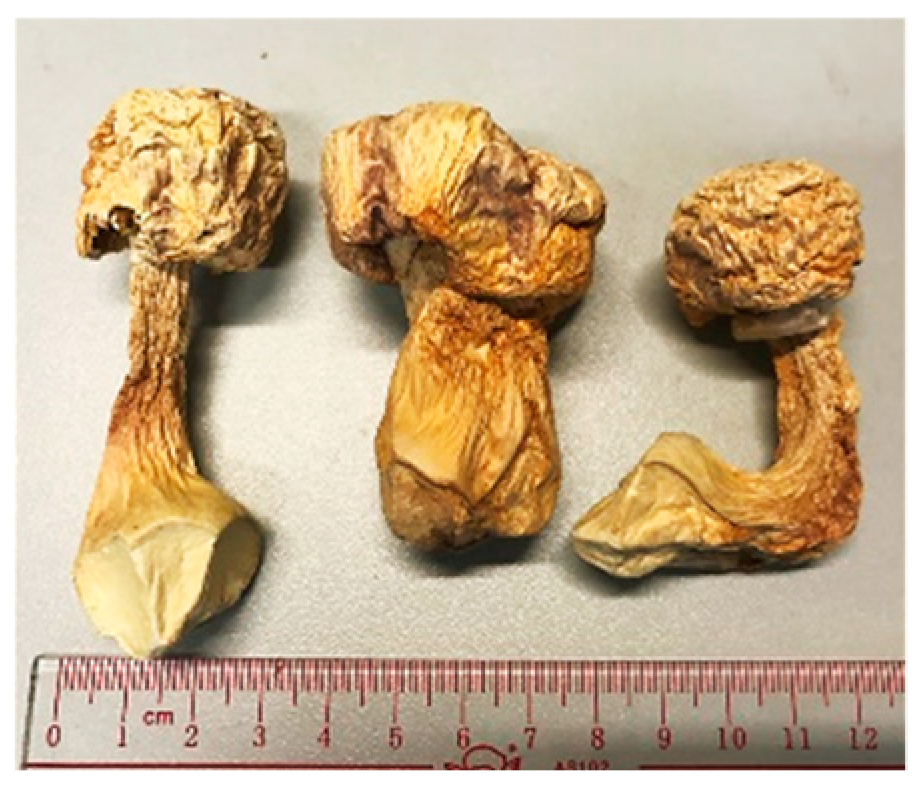 | Brazil, East Asia | Cancer, inflammatory/allergy conditions | Crude extracts | Anti-cancer effects | [12,13] |
| (2) Ganoderma lucidum |  | China, East Asia | Longevity, cancer | Triterpenes, polysaccharides | Immunomodulatory effects | [18,19,20,21,22,23,24] |
| Ganoderma sinense | 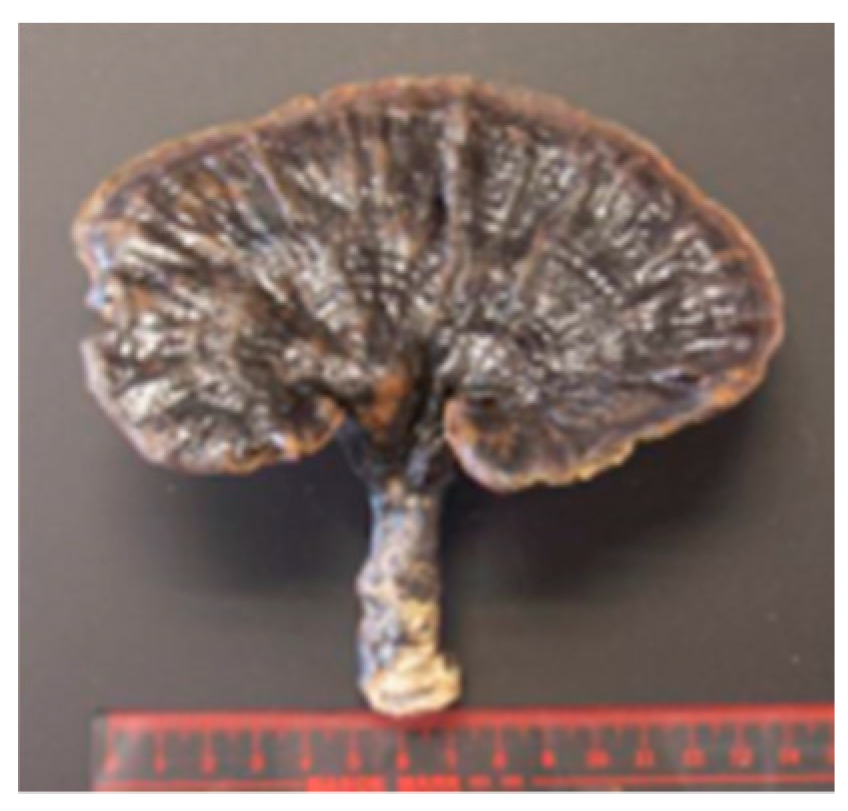 | |||||
| (3) Rubinoboletus ballouii | 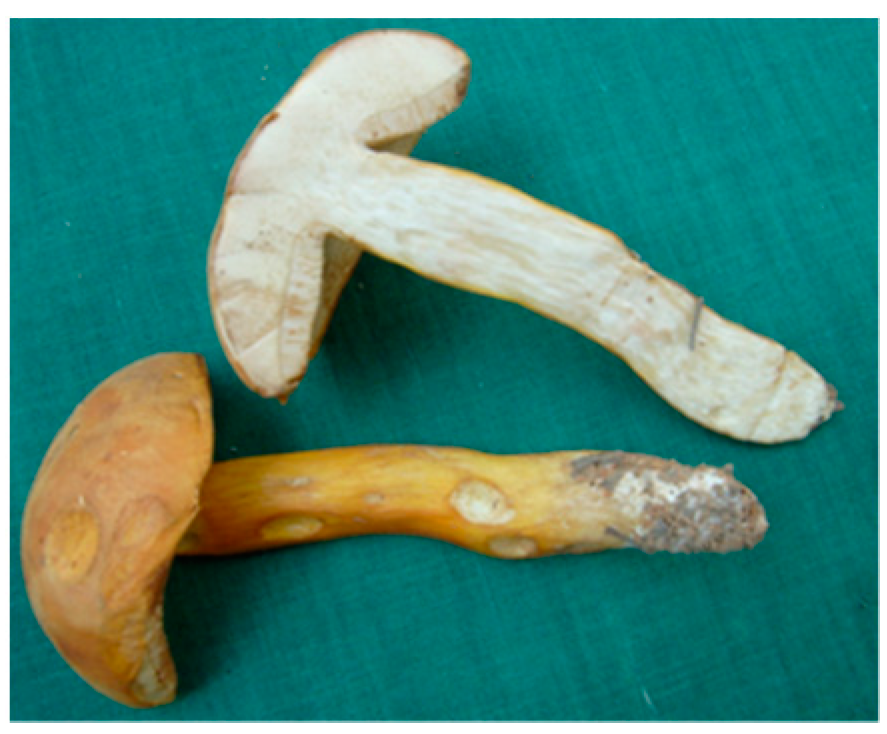 | Southwest China | Folk practice | Polysaccharides | Anti-inflammation, immunomodulatory effects | [8,9] |
| (4) Acanthopanax senticosus | 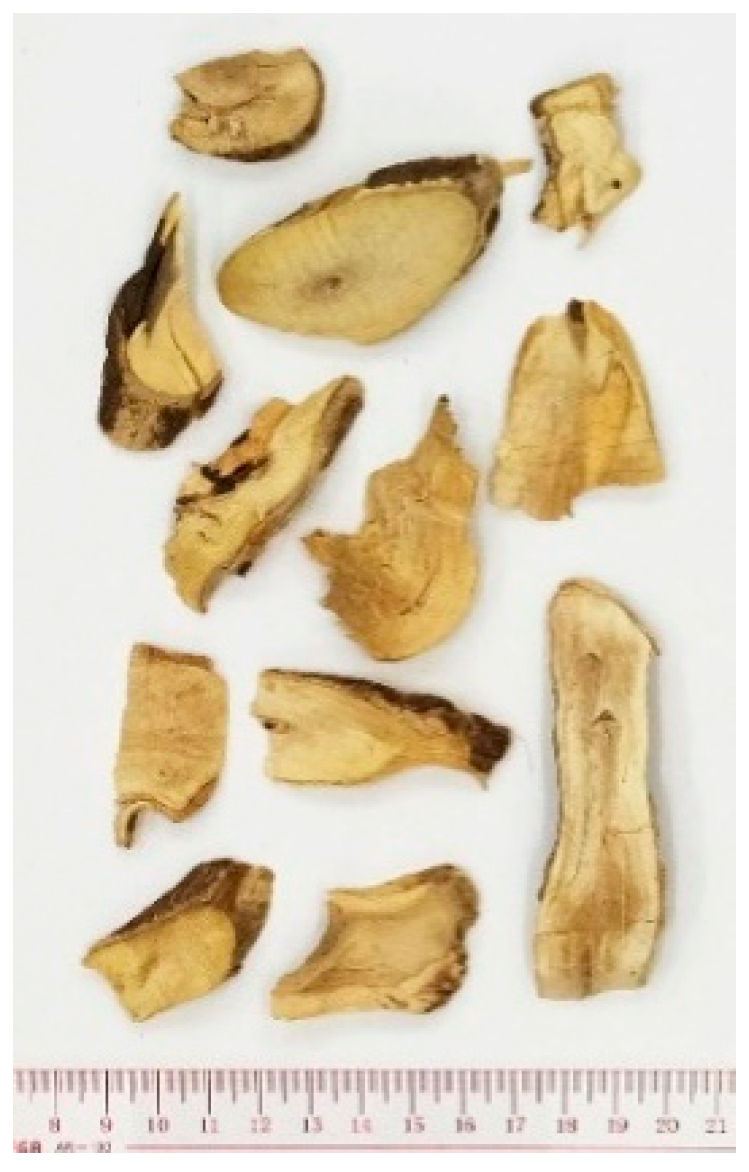 | North China | Cancer, rejuvenation | Crude extracts | Immunomodulatory effects | [32] |
| (5) Astragalus membranaceus | 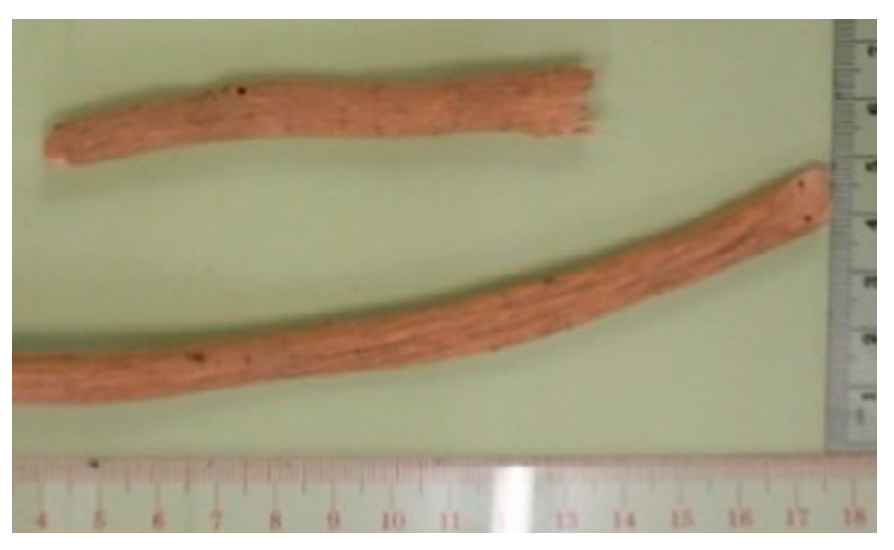 | North China | Rejuvenation, infection | Polysaccharides | Immunomodulatory effects | [3,4,5] |
| (6) Curcuma longa | 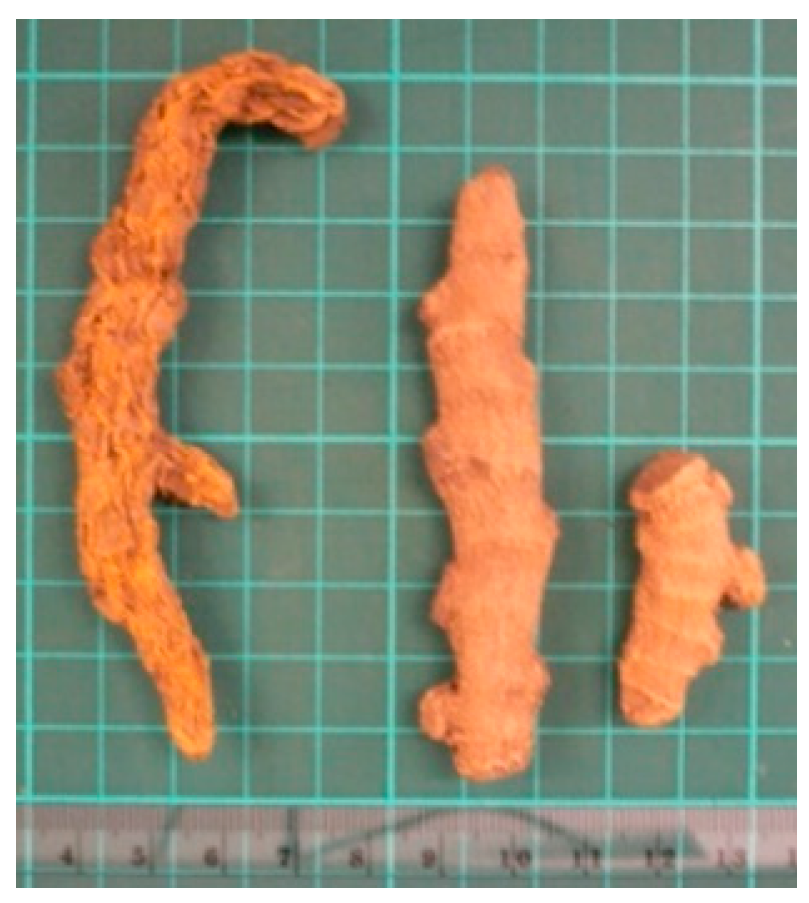 | India, South China | Anti-aging, antioxidant, cancer | Crude extracts | Anti-inflammation, anti-angiogenesis, immunomodulatory effects | [6,7,33,34,35,36,37,38] |
| (7) Hedyotis diffusa | 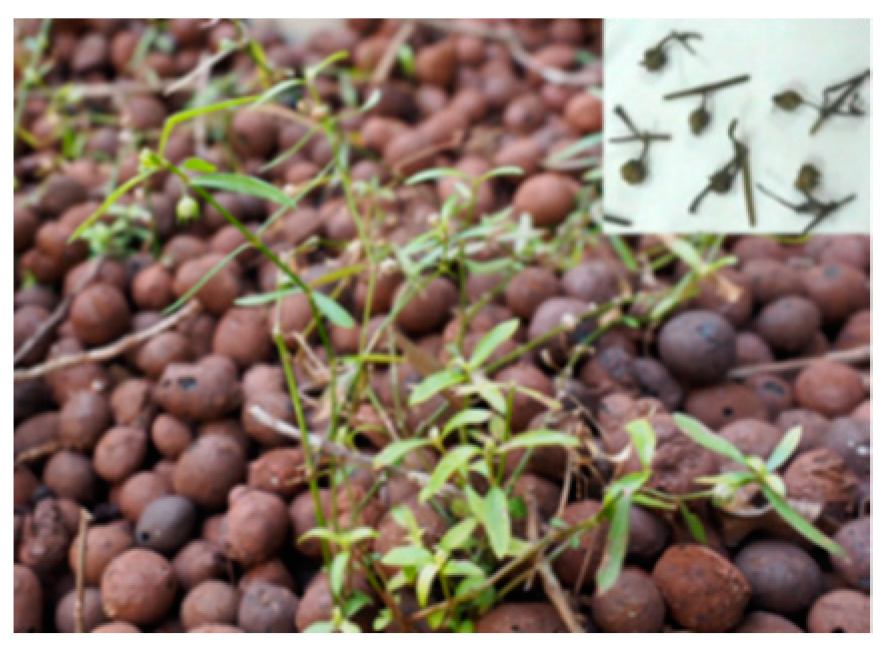 | South China | Cancer | Crude extracts | Anti-angiogenesis, anti-cancer | [39,40,41] |
| (8) Scutellaria barbata | 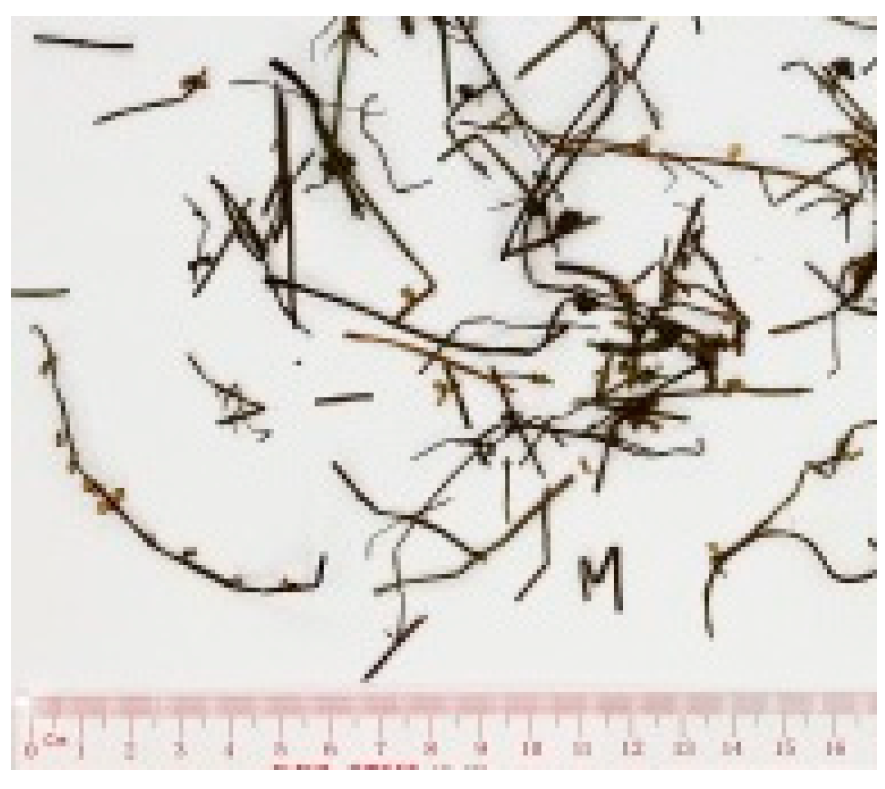 | China | Infection, allergy | Crude extracts.Pheophorbide a | Anti-inflammation, detoxication, anti-cancer | [42,43,44,45] |
Publisher’s Note: MDPI stays neutral with regard to jurisdictional claims in published maps and institutional affiliations. |
© 2021 by the authors. Licensee MDPI, Basel, Switzerland. This article is an open access article distributed under the terms and conditions of the Creative Commons Attribution (CC BY) license (https://creativecommons.org/licenses/by/4.0/).
Share and Cite
Yue, G.G.-L.; Lau, C.B.-S.; Leung, P.-C. Medicinal Plants and Mushrooms with Immunomodulatory and Anticancer Properties—A Review on Hong Kong’s Experience. Molecules 2021, 26, 2173. https://doi.org/10.3390/molecules26082173
Yue GG-L, Lau CB-S, Leung P-C. Medicinal Plants and Mushrooms with Immunomodulatory and Anticancer Properties—A Review on Hong Kong’s Experience. Molecules. 2021; 26(8):2173. https://doi.org/10.3390/molecules26082173
Chicago/Turabian StyleYue, Grace Gar-Lee, Clara Bik-San Lau, and Ping-Chung Leung. 2021. "Medicinal Plants and Mushrooms with Immunomodulatory and Anticancer Properties—A Review on Hong Kong’s Experience" Molecules 26, no. 8: 2173. https://doi.org/10.3390/molecules26082173
APA StyleYue, G. G.-L., Lau, C. B.-S., & Leung, P.-C. (2021). Medicinal Plants and Mushrooms with Immunomodulatory and Anticancer Properties—A Review on Hong Kong’s Experience. Molecules, 26(8), 2173. https://doi.org/10.3390/molecules26082173






